Зоологический журнал, 2021, T. 100, № 2, стр. 170-185
Two new species of oribatid mites (Acari, Oribatida) from Malaysia
S.G. Ermilov a, *, S. Kalúz b, **
a Tyumen State University
625003 Tyumen, Russia
b Institute of Zoology, Slovak Academy of Sciences
84506 Bratislava, Slovakia
* E-mail: ermilovacari@yandex.ru
** E-mail: stanislav.kaluz@gmail.com
Поступила в редакцию 28.08.2019
После доработки 19.01.2020
Принята к публикации 28.02.2020
Аннотация
Two new species of oribatid mites (Acari, Oribatida) are described from Western Malaysia, one each in the genera Eurhynchoribates (Rhynchoribatidae) and Sadocepheus (Cepheidae). Eurhynchoribates jendeki sp. n. differs from E. excelsior (Mahunka 1985) in the larger body size; the absence of a triangular tubercle between insertions of the lamellar setae; and the presence of the following characters: thickened lamellar and interlamellar setae, cerotegumental reticulate ornamentation on notogaster, furrows on anal plates and in adanal region, and foveolae in aggenital region. Sadocepheus sausai sp. n. differs from S. yakuensis Aoki 2006 in the presence of long adanal setae, long posterior notogastral setae p1–p3, and some long epimeral setae.
The goal of the paper is to describe and illustrate two new species of oribatid mites (Acari, Oribatida), which were collected from Malaysia. One species belongs to the genus Eurhynchoribates Miko 2016 (family Rhynchoribatidae), and the other – to Sadocepheus Aoki 1965 (family Cepheidae).
Eurhynchoribates includes two subgenera and 15 species, which are distributed in the Ethiopian and Oriental regions (Subías, 2019). The main morphological diagnostic characteristics of this genus were summarized by Miko (2016) and Miko et al. (2017). Sadocepheus includes 14 species and one subspecies, which are distributed in the Oriental, Neotropical and eastern Palaearctic regions, as well as in New Zealand and in the U.S.A. (Subías, 2019; Ermilov, Rybalov, 2019). The main morphological diagnostic characteristics of this genus were summarized by Ermilov and Corpuz-Raros (2017).
Prior to our study, representatives of Eurhynchoribates have never been registered in Malaysia, while only one species of Sadocepheus has been recorded (Mahunka, 1987).
This work is a part of our ongoing study of oribatid mite fauna of Malaysia (e.g., Ermilov, 2016; Ermilov, Kalúz, 2019, 2019a).
METHODS
Specimens were mounted in lactic acid on temporary cavity slides for measurement and illustration. Body length was measured in lateral view, from the tip of the rostrum to the posterior edge of the notogaster. Notogastral width refers to the maximum width of the notogaster in dorsal view. Lengths of body setae were measured in lateral aspect. All body measurements are presented in micrometers. Formulas for leg setation are given in parentheses according to the sequence trochanter–femur–genu–tibia–tarsus (famulus included). Formulas for leg solenidia are given in square brackets according to the sequence genu–tibia–tarsus.
Drawings were made with a camera lucida using a Leica transmission light microscope “Leica DM 2500”. SEM micrographs were made with the aid of a JEOL–JSM-6510LV SEM microscope.
Morphological terminology used in this paper follows that of F. Grandjean: see Travé and Vachon (1975) for references, Norton (1977) for leg setal nomenclature, and Norton and Behan-Pelletier (2009), for overview.
The following abbreviations are used: ro, le, in, bs, ex – rostral, lamellar, interlamellar, bothridial and exobothridial setae, respectively; tu – tutorium; c, la, lm, lp, h, p – notogastral setae; cr – crista; ia, im, ip, ih, ips – notogastral lyrifissures; gla – opisthonotal gland opening; a, m, h – subcapitular setae; or – adoral seta; ω – palp and leg solenidion; cha, chb = cheliceral setae; Tg = Trägårdh’s organ; PdI, PdII – pedotecta I, II, respectively; 1a, 1b, 1c, 2a, 3a, 3b, 3c, 4a, 4b, 4c, 4d, 4e – epimeral setae; dis – discidium; g, ag, an, ad – genital, aggenital, anal and adanal setae, respectively; iad – adanal lyrifissure; po – preanal organ; Tr, Fe, Ge, Ti, Ta – leg trochanter, femur, genu, tibia, tarsus, respectively; pa – leg porose area; σ, φ – leg solenidia; ɛ – leg famulus.
SYSTEMATICS
Superfamily Trizetoidea
Family Rhynchoribatidae
Genus Eurhynchoribates Miko 2016
Subgenus Eurhynchoribates (Eurhynchoribates) Miko 2016
Type species: Rhynchoribates borhidii Mahunka 1986
Eurhynchoribates jendeki Ermilov et Kalúz sp. n. (Figs 1–6)
Fig. 1.
Eurhynchoribates jendeki sp. n., adult: a – dorsal view (legs not illustrated); b – rostrum, lateral view; c – part of prodorsum, lateral view; d – part of notogaster, lateral view; e – part of notogaster and podosomal region, lateral view. Scale bar: 100 µm.
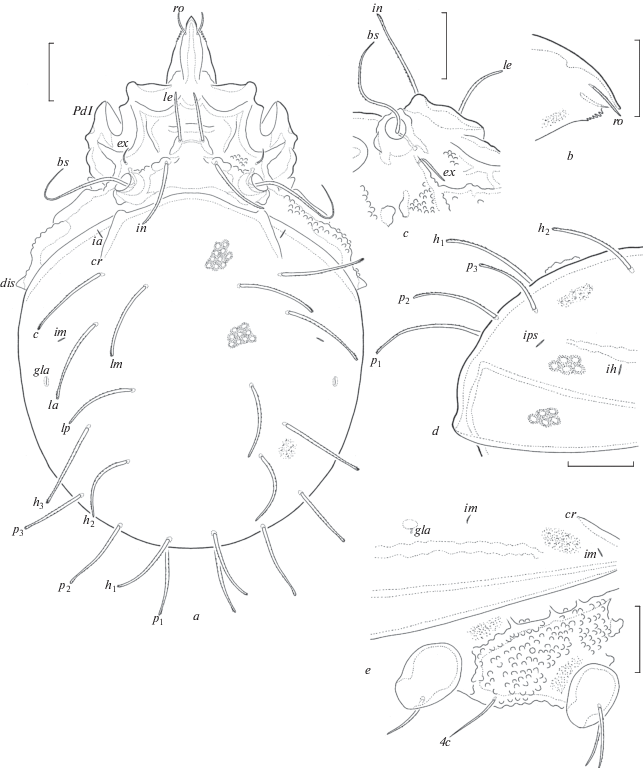
Fig. 2.
Eurhynchoribates jendeki sp. n., adult: a – ventral view (gnathosoma and legs not illustrated); b – part of notogaster, posterior view; c – subcapitulum, ventral view; d – palp, left, ventroparaxial view; e – chelicera, right, antiaxial view. Scale bar (µm): a, b – 100; c–e – 20.
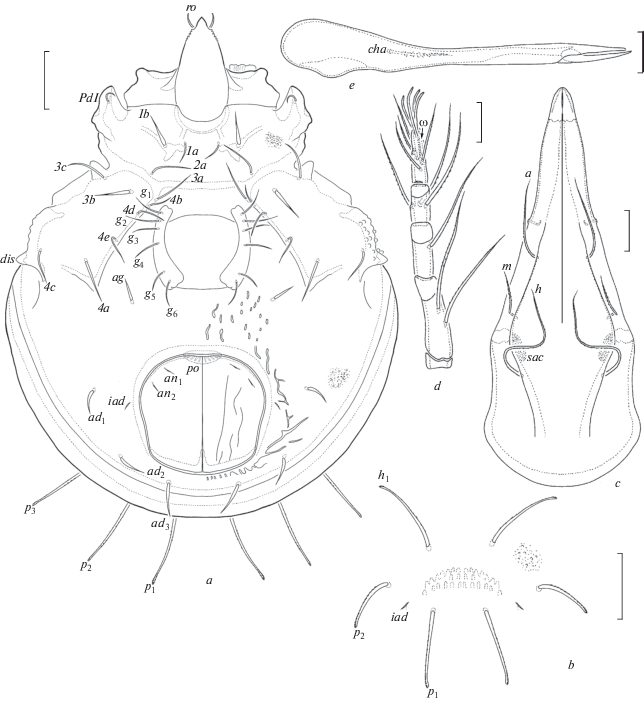
Fig. 3.
Eurhynchoribates jendeki sp. n., adult: a – leg I, without trochanter and basal part of femur, right, antiaxial view; b – leg II, without trochanter and basal part of femur, right, antiaxial view; c – leg III, right, antiaxial view; d – leg IV, left, antiaxial view. Scale bar: 50 µm.
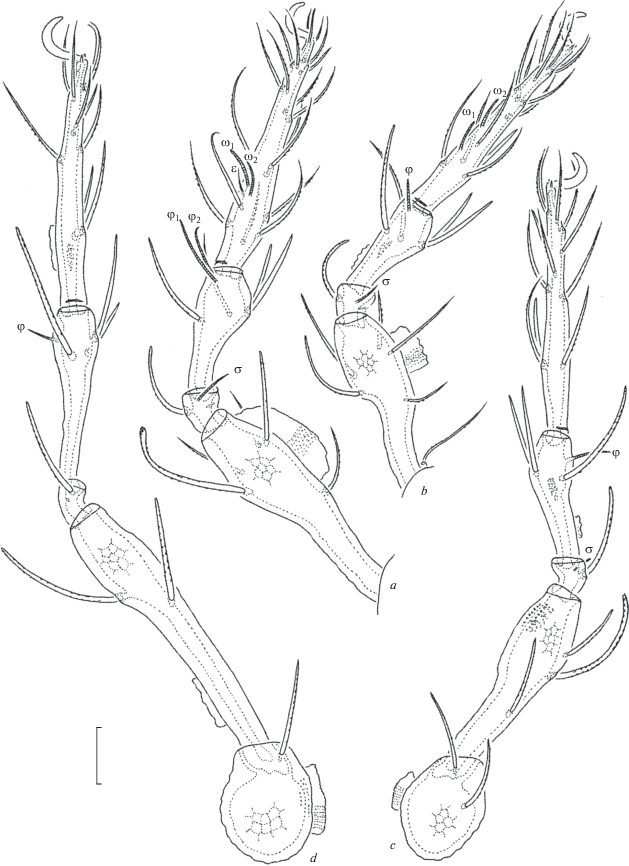
Fig. 4.
Eurhynchoribates jendeki sp. n., adult, SEM micrographs: a – dorsal view; b – ventral view; c–e – part of notogastral surface and cerotegument. Scale bar (µm): a – 200; b – 100; c, d – 10; e – 2.
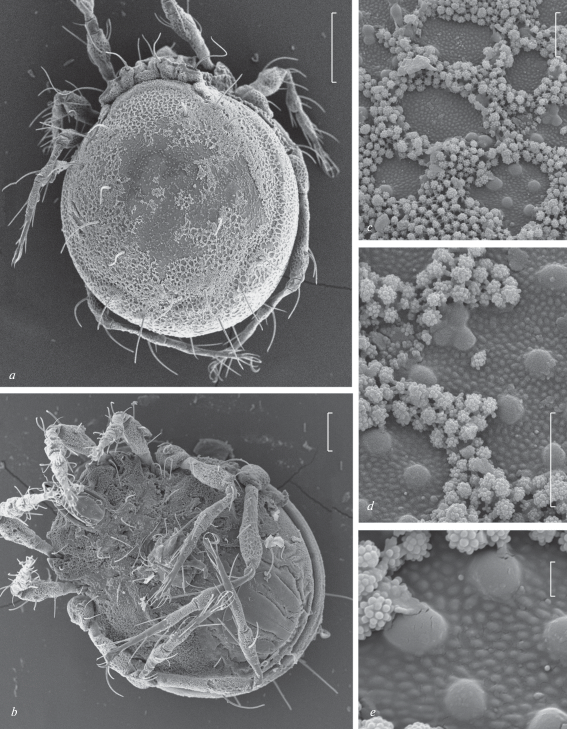
Fig. 5.
Eurhynchoribates jendeki sp. n., adult, SEM micrographs: a – lateral view; b – part of prodorsum and notogaster, lateral view. Scale bar (µm): a – 200, b – 50.
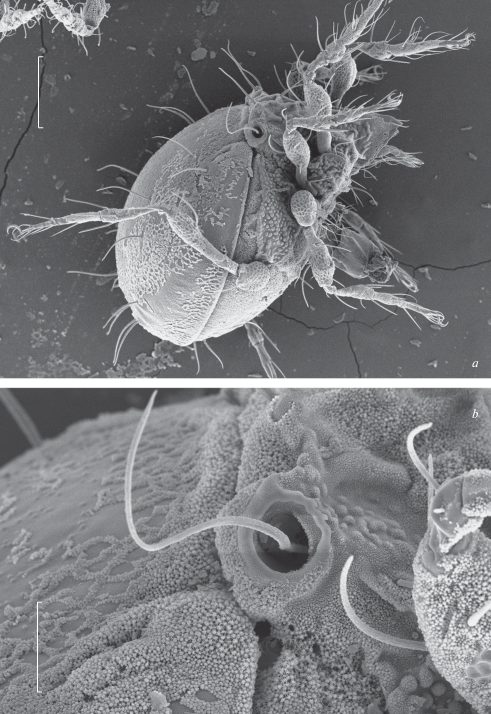
Fig. 6.
Eurhynchoribates jendeki sp. n., adult, SEM micrographs: a – part of rostrum, lateral view; b – notogastral seta h1; c – structure of notogastral cerotegumental granules; d – part of surface and cerotegument of leg femur II. Scale bar (µm): a, b – 20; c – 1; d – 10.
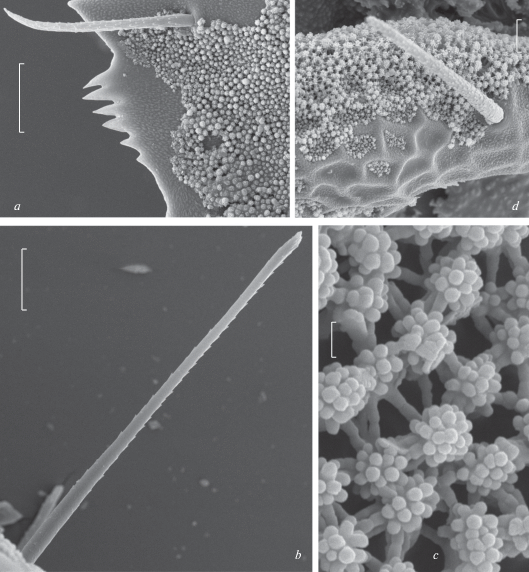
Material. Holotype (♂) and four paratypes (2♀♀, 2♂♂): Malaysia, Perak District, 50 km NE to Gerik, Titiwangsa, 05°36′17.4″ N, 101°32′34.0″ E, alt. 1100 m, forest complex Belum–Temenggor, litter, 30.III–13.IV.2015 (E. Jendek, O. Šauša).
The holotype is deposited in the collection of the Institute of Zoology, Slovak Academy of Sciences, Bratislava, Slovakia; four paratypes are deposited in the collection of the Tyumen State University Museum of Zoology, Tyumen, Russia. All specimens are in ethanol with drop of glycerol.
Diagnosis. Body size: 929–962 × 647–680. Notogastral granulate cerotegument forming partially specific reticulate pattern on notogaster. Anal plates and adanal region with furrows, aggenital region foveolate. Rostrum pointed, with five to seven lateral teeth. Rostral and exobothridial setae short, slightly thickened, barbed, ro arch-like. Lamellar and interlamellar setae long, thickened, barbed. Bothridial setae setiform, barbed. Ten pairs of notogastral setae long, thickened, barbed. Epimeral setal formula: 3–1–3–5;1b, 3b and 4a phylliform, barbed, others setiform, barbed. Genital setae setiform, barbed. Aggenital and adanal setae narrowly phylliform, barbed. Anal setae short, setiform, smooth, inserted in anterior part of anal plates. Adanal lyrifissures diagonal.
Description. Measurements. Body length: 929 (holotype), 929–962 (paratypes); notogaster width: 647 (holotype), 647–680 (paratypes). No difference between females and males in body size.
Integument (Figs 1a–1e; 2a; 3a–3d; 4a, 4c–4e; 5a, 5b; 6a, 6c, 6d). Color dark reddish brown. Surface densely microtuberculate (diameter or length of tubercles less than 1) and with larger sparse tubercles (their diameter up to 6) (Figs 4c–4e; 6a). Podosomal regions and lateral parts of prodorsum densely macrotuberculate (diameter of tubercles up to 16) (Figs 5a, 5b). Anal plates with some longitudinal furrows (Figs 2a; 4b). Adanal region with thickenings bordered by curved furrows (Fig. 4b). Oval and elongate foveolae present between genital and anal apertures (Figs 2a; 4b). All leg femora and trochanters III, IV with concavities forming reticulate pattern (Figs 5a; 6d). Body and legs covered by distinct layer of granulate cerotegument (Figs 4a, 4c–4e; 5a, 5b; 6a, 6c, 6d), which partially forming reticulate pattern on notogaster (Figs 4a; 5a, 5b), granules consist of dense microgranules (Figs. 4c–4e; 6c).
Prodorsum (Figs 1a–1c; 4a; 5a, 5b; 6a). Rostrum elongate triangular, pointed, with five to seven small teeth laterally. System of prodorsal ridges well-developed, anterior dorsolateral semi-oval concavities (tectopedial fields) present. Rostral (45–53) and exobothridial (45–49) setae slightly thickened, barbed, ro arch-like and directed anteriorly or anteromedially. Lamellar (98–102) and interlamellar (135–143) setae thickened, sometimes slightly swollen distally, barbed, le inserted on short separate thickenings. Bothridial setae (209–217) setiform, S-form, barbed. Postbothridial tubercles slightly developed.
Notogaster (Figs 1a, 1d, 1e; 2b; 4a; 5a, 5b; 6b). Anterior margin convex medially, with one pair of humeral tubercles and one pair of short cristae, located posterior to bothridia. Ten pairs of notogastral setae comparatively long (143–157; up to 169 sometimes), thickened, often slightly swollen distally, barbed. Lateral notogastral porose areas absent. Lyrifissures and opisthonotal gland openings distinct.
Gnathosoma (Figs 2c–2e; 5a). Subcapitulum longer than wide (196–200 × 61–69). Subcapitular setae (a, 49–53; m, 28–32; h, 65–69) setiform, barbed, inserted on two long, longitudinal arch-like ridges. Adoral setae absent. Axillary sacculi large, distinctly visible. Palps (length 127–131) with setation 0–2–1–3–8(+ω). Solenidion of palptarsi of medium size, bacilliform, pressed to the surface of palptarsi. Postpalpal setae not observed. Chelicerae (length 176–180) with one setiform, barbed seta (cha, 32–36), seta chb and Trägårdh’s organ not observed.
Epimeral and lateral podosomal regions (Figs 1e; 2a; 4b; 5a). Epimeral and ventrosejugal tubercles absent, but unclear thickenings present instead it. Epimeral porose areas not observed. Epimeral setal formula: 3–1–3–5. Setae 1b, 3b and 4a (86–90) narrowly phylliform, barbed, 1a, 1c, 4b (41–49), and others (77–82) setiform, barbed. Setae 3a, 4a, 4b, 4d, and 4e located on strong diagonal ridges, 3c inserted at base of large ventropodosomal tubercles. Pedotecta I represented by small lamina. Circumpedal ridges indistinct. Discidia triangular.
Anogenital region (Figs 2a; 4b; 5a). Six pairs of genital setae (g1, g2, 61–65; g3–g6, 49–53) setiform, barbed. One pair of aggenital (65–69) and three pairs of adanal (61–69 up to 90 sometimes) setae narrowly phylliform, barbed. Distance of insertions ad1–ad2 distinctly shorter than ad2–ad3. Two pairs of anal setae (12–16) setiform, thin, smooth, inserted in anterior part of anal plates. Adanal lyrifissures diagonal, slightly distanced from the anal aperture.
Legs (Figs 3a–3d; 4a, 4b; 5a; 6d). Claw of each leg smooth. Formulas of leg setation and solenidia: I (1–5–2–4–20) [1–2–2], II (1–5–2–4–16) [1–1–2], III (2–3–1–3–15) [1–1–0], IV (1–2–2–3–12) [0–1–0]; homology of setae and solenidia indicated in Table 1. All solenidia of medium size, thickened, blunt-ended. Famulus of tarsi I setiform, inserted posterior to solenidion ω1. Setae p setiform on legs I and thorn-like on legs II–IV.
Table 1.
Leg setation and solenidia of adult Eurhynchoribates jendeki sp. n.
| Leg | Tr | Fe | Ge | Ti | Ta |
|---|---|---|---|---|---|
| I | v ' | d, (l), bv '', v '' | (l), σ | (l), (v), φ1, φ2 | (ft), (tc), (it), (p), (u), (a), s, (pv), v ', (pl), l '', ɛ, ω1, ω2 |
| II | v ' | d, (l), bv '', v '' | (l), σ | (l), (v), φ | (ft), (tc), (it), (p), (u), (a), s, (pv), l '', ω1, ω2 |
| III | l ', v ' | d, l ', ev ' | l ', σ | l ', (v), φ | (ft), (tc), (it), (p), (u), (a), s, (pv) |
| IV | v ' | d, ev ' | d, l ' | l ', (v), φ | ft '', (tc), (p), (u), (a), s, (pv) |
Remarks. Eurhynchoribates jendeki sp. n. is similar to E. excelsior (Mahunka 1985) from the Ethiopian region (see Mahunka, 1985) in the presence of: triangular rostrum; long lamellar and interlamellar setae; long, thickened and barbed notogastral setae; narrowly phylliform aggenital and adanal setae. However, the former species differs from the latter in larger body size (929–962 × 647–680 versus 713–852 × 460–582); the absence (versus presence) of triangular tubercle between insertions on lamellar setae; and the presence of the following: thickened (versus setiform) lamellar and interlamellar setae; cerotegumental reticulate ornamentation on notogaster, furrows on anal plates and in adanal region, foveolae in aggenital region.
Etymology. The new species is named after Dr. Eduard Jendek, entomologist from the Slovak Entomological Society, Bratislava, Slovakia.
Superfamily Eutegaeoidea Family Cepheidae Genus Sadocepheus Aoki 1965 Subgenus Sadocepheus (Sadocepheus) Aoki 1965 Type species: Sadocepheus undulatus Aoki 1965
Sadocepheus sausai Ermilov et Kalúz sp. n. (Figs 7–12)
Fig. 7.
Sadocepheus sausai sp. n., adult: a – dorsal view (legs not illustrated); b – part of anoadanal region, posterior view; c – part of prodorsum, lateral view; d – part of notogaster and podosomal region, lateral view. Scale bar: 100 µm.
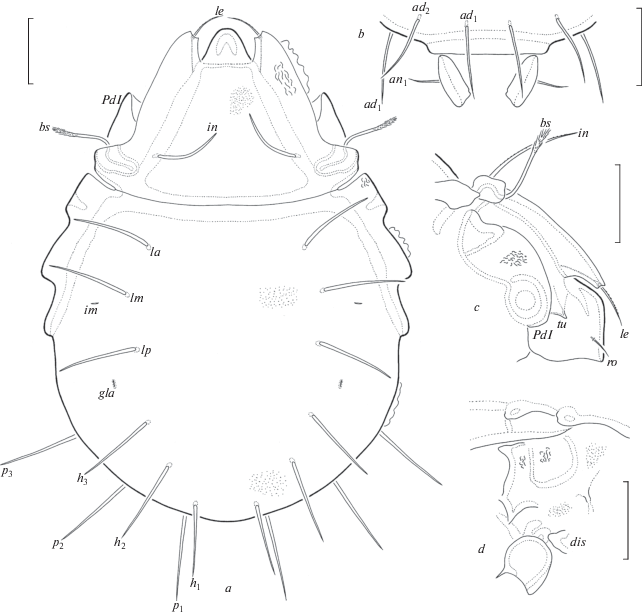
Fig. 8.
Sadocepheus sausai sp. n., adult: a – ventral view (gnathosoma and legs not illustrated); b – part of notogaster, posterior view; c – part of notogaster, lateral view; d – subcapitulum, ventral view; e – palp, left, paraxial view; f – chelicera, left, paraxial view. Scale bar (µm): a–c – 100; d–f – 20.
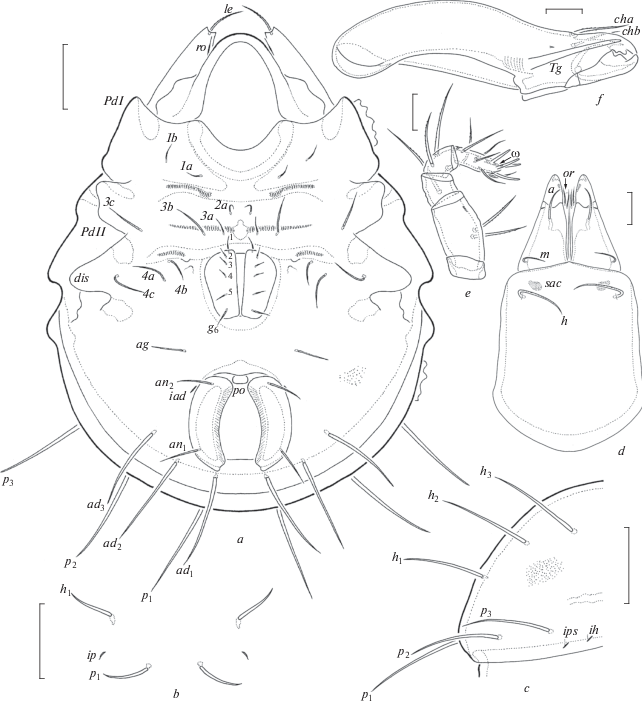
Fig. 9.
Sadocepheus sausai sp. n., adult: a – leg I, right, antiaxial view; b – leg II, without trochanter and basal part of femur, right, antiaxial view; c – leg III, left, antiaxial view; d – leg IV, left, antiaxial view. Scale bar: 50 µm.
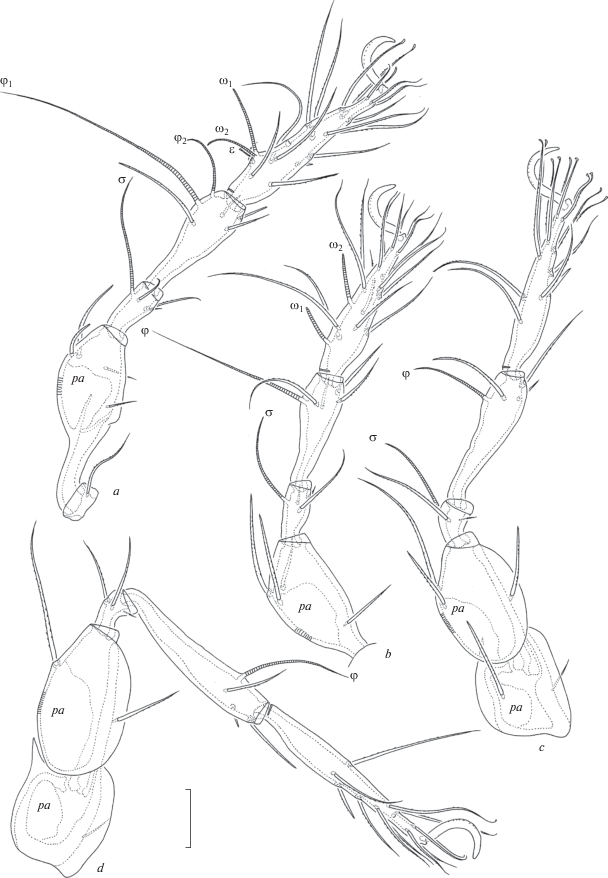
Fig. 10.
Sadocepheus sausai sp. n., adult, SEM micrographs: a – dorsal view; b – ventral view; c, d – part of prodorsal surface and cerotegument; e – part of notogastral surface and cerotegument. Scale bar (µm): a, b – 100; c – 20; d – 5; e – 10.
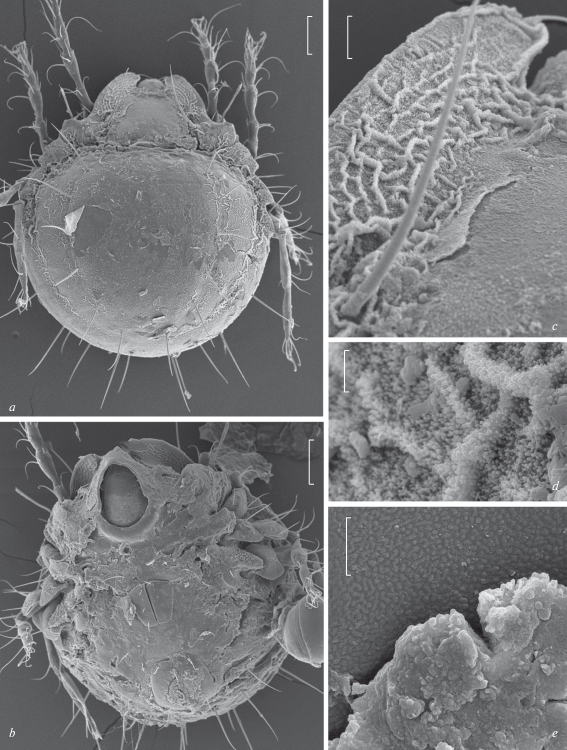
Fig. 11.
Sadocepheus sausai sp. n., adult, SEM micrographs: a – lateral view; b – dorsofrontal view. Scale bar: 100 µm.
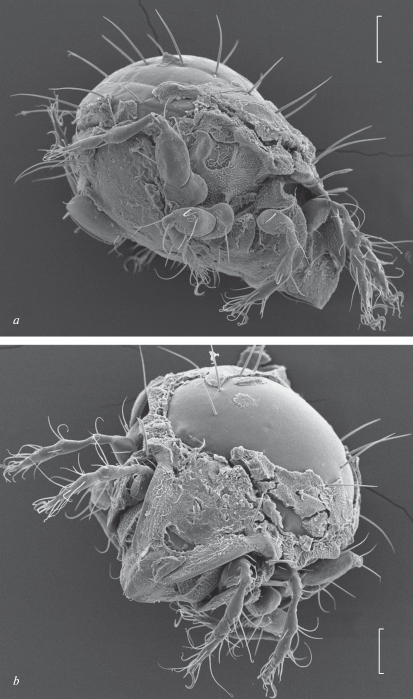
Fig. 12.
Sadocepheus sausai sp. n., adult, SEM micrographs: a – posterior view; b – bothridial seta; c – notogastral seta h1. Scale bar (µm): a – 100; b, c – 20.
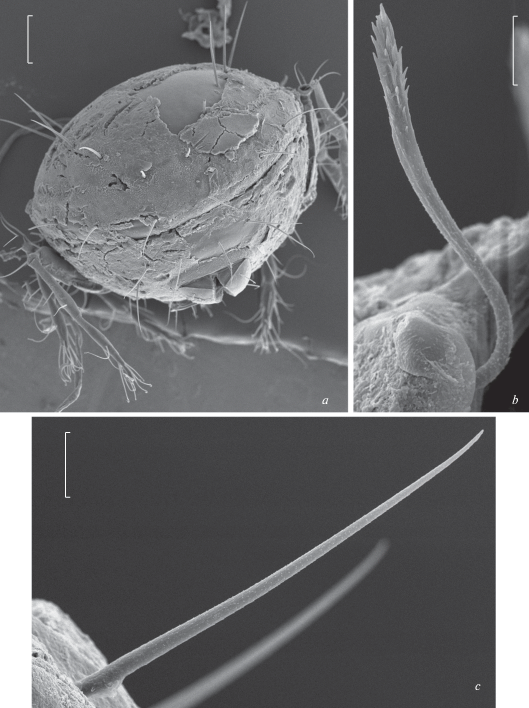
Material. Holotype (♂) and 16 paratypes (8♀♀, 8♂♂): Malaysia, Perak District, 50 km NE to Gerik, Titiwangsa, 05°36′17.4″ N, 101°32′34.0″ E, alt. 1100 m, forest complex Belum–Temenggor, litter, 30.III–13.IV.2015 (E. Jendek, O. Šauša).
The holotype is deposited in the collection of the Institute of Zoology, Slovak Academy of Sciences, Bratislava, Slovakia; 14 paratypes are deposited in the collection of the Tyumen State University Museum of Zoology, Tyumen, Russia; two paratypes are deposited in the collection of the Senckenberg Institute, Görlitz, Germany. All specimens are in ethanol with drop of glycerol.
Diagnosis. Body size: 680–796 × 514–647. Lamellae with granulate rugae. Lamellae bidentate, with small medial and lateral teeth and slight, semi-oval indentation between them. Rostral and lamellar setae setiform, barbed. Interlamellar setae long, thickened, roughened. Bothridial setae long, with brush-like head. Nine pairs of notogastral setae long, thickened, roughened, dorsal setae located in two parallel dorsolateral rows. Epimeral setal formula: 2–1–3–3. Epimeral and anogenital setae setiform, roughened; adanal setae comparatively long. Leg trochanters III, IV with tooth dorsoanteriorly.
Description. Measurements. Body length: 680 (holotype), 680–796 (paratypes); notogaster width: 514 (holotype), 514–647 (paratypes). No clear difference between females and males in body size, but females usually larger.
Integument (Figs 7a; 8a; 10a–10e; 11a, 11b; 12a). Color dark brown. Surface densely microtuberculate and microrugose (diameter or length of tubercles and rugae less than 1) (Fig. 10e). Lamellae, podosomal regions and lateral parts of prodorsum additionally with larger granules which are consist from microgranules; granules sometimes forming rugae (Figs 10a–10d, 11a, 11b). Body covered by thick, block-like layer of cerotegument (Figs 10a–10e, 11a, 11b, 12a).
Prodorsum (Figs 7a, 7c; 8a; 10a–10c; 11a, 11b; 12b). Rostrum rounded. Rostral region hump-like. Lamellae bidentate, with small medial and lateral teeth and slight, semi-oval indentation between them. Translamella thin, slightly developed, or not observed. Rostral (28–32) and lamellar (61–65) setae setiform, barbed. Interlamellar setae (147–155) thickened, roughened. Bothridial setae (123–131) with long stalk and short, brush-like head. Exobothridial setae and their alveoli absent. Tutoria slightly developed, triangular distally.
Notogaster (Figs 7a; 8a–8c; 10a; 11a; 12a, 12c). Anterior margin of notogaster slightly concave medially. Humeral regions triangular. Nine pairs of notogastral setae (139–155) thickened, roughened, inserted on the notogastral surface, dorsal setae located in two parallel dorsolateral rows. Lyrifissures and opisthonotal gland openings distinct.
Gnathosoma (Figs 8d–8f). Subcapitulum longer than wide (184–188 × 110–123). Subcapitular setae (a, 24–28; m, 16–20; h, 45–53) setiform, barbed. Adoral setae (14–16) setiform, smooth. Palps (length 102–110) with typical setation 0–2–1–3–9(+ω). Solenidion of palptarsi of medium size, bacilliform, pressed to the surface of palptarsi. Postpalpal setae (8) spiniform, smooth. Axillary sacculi large, distinctly visible. Chelicerae (length 164–172) with two setiform, barbed setae (28–32). Trägårdh’s organ of chelicerae tapered.
Epimeral and lateral podosomal regions (Figs 7d; 8a; 10b; 11a). Epimere IV with two pairs of slight, opposite tubercles located near to genital aperture. Epimeral setal formula: 2–1–3–3; setae 1c and their alveoli absent. Setae setiform, roughened, 1a and 2a (16) shorter than 1b, 3a (20–24) and others (57–69). Pedotecta I represented by large lamina, pedotecta II represented by small, rectangular (in ventral aspect) lamina. Circumpedal ridges not observed. Discidia elongate triangular, rounded distally.
Anogenital region (Figs 7b; 8a; 10b; 11a; 12a). Six pairs of genital (g1, g6, 32, g2–g4, 20; g5, 24), one pair of aggenital (53–65), three pairs of adanal (110–131 up to 151 in some specimens), and two pairs of anal (53–65) setae setiform, roughened. Adanal setae inserted in posterolateral position to anal plates, equal distanced from each other. Adanal lyrifissures diagonal, located close to anal aperture.
Legs (Figs 9a–9d; 10a, 10b; 11a, 11b; 12a). Claw of each leg slightly barbed on dorsal side. Trochanters III, IV with strong tooth dorsoanteriorly. Porose areas on all femora and on trochanters III, IV distinctly visible. Formulas of leg setation and solenidia: I (1–4–3–4–19) [1–2–2], II (1–4–3–4–16) [1–1–2], III (2–3–2–3–15) [1–1–0], IV (1–2–2–3–12) [0–1–0]; homology of setae and solenidia indicated in Table 2. Solenidion on all tibiae and on genua I-III setiform, solenidia on tarsi I, II thickened, blunt-ended. Famulus of tarsi I straight, slightly truncate and swollen distally, inserted posterior to solenidion ω1.
Table 2.
Leg setation and solenidia of adult Sadocepheus sausai sp. n.
| Leg | Tr | Fe | Ge | Ti | Ta |
|---|---|---|---|---|---|
| I | v ' | d, (l), bv '' | (l), v ', σ | (l), (v), φ1, φ2 | (ft), (tc), (it), (p), (u), (a), s, (pv), (pl), l '', ɛ, ω1, ω2 |
| II | v ' | d, (l), bv '' | (l), v ', σ | (l), (v), φ | (ft), (tc), (it), (p), (u), (a), s, (pv), l '', ω1, ω2 |
| III | l ', v ' | d, l ', ev ' | l ', v ', σ | l ', (v), φ | (ft), (tc), (it), (p), (u), (a), s, (pv) |
| IV | v ' | d, ev ' | d, l ' | l ', (v), φ | ft '', (tc), (p), (u), (a), s, (pv) |
See Table 1 for explanations.
Remarks. Sadocepheus sausai sp. n. is similar to S. yakuensis Aoki 2006 from Japan (see Aoki, 2006) in the presence of: long interlamellar setae; slightly developed, brush-like bothridial heads; as well as long, thickened dorsal notogastral setae, located in two dorsolateral rows. However, the former species differs from the latter in the presence of long (versus short) adanal setae, posterior notogastral setae p1–p3, and some epimeral setae.
Etymology. The new species is named after Dr. Ondrej Šauša, entomologist from the Slovak Entomological Society, Bratislava, Slovakia.
Список литературы
Aoki J., 2006. New and newly recorded oribatid mites (Arachnida, Acari, Oribatida) from the Ryukyu Islands, Japan // Bulletin of the National Museum of Natural Science, Tokyo, Serie A. V. 32. № 3. P. 105–124.
Ermilov S.G., 2016. Additions to the oribatid mite fauna of Malaysia, with description of a new species of the genus Lohmannia (Acari, Oribatida, Lohmanniidae) // Acarina. V. 24. № 2. P. 159–165.
Ermilov S.G., Kalúz S., 2019. Meristacarus bochkovi (Acari, Oribatida, Lohmanniidae), a new species of oribatid mites from Malaysia // Acarina. V. 27. № 2. P. 175–182.
Ermilov S.G., Kalúz S., 2019a. New and interesting galumnoid mites (Acari, Oribatida, Galumnoidea) from Malaysia // Systematic and Applied Acarology. V. 24. № 9. P. 1711–1723.
Ermilov S.G., Rybalov L.B., 2019. Oribatid mites from the vicinities of Dhati-Walal National Park, Ethiopia (Acari, Oribatida) //Spixiana. 42. № 2. P. 235–252.
Mahunka S., 1985. Description and redescription of Ethiopian oribatids (Acari, Oribatida), II // Annales Historico-Naturales Musei Nationalis Hungarici. V. 77. P. 233– 249.
Mahunka S., 1987. Neue und interessante Milben aus dem Genfer Museum LX. Oribatids from Sabah (East Malaysia) II. (Acari: Oribatida) // Revue Suisse de Zoologie. V. 94. № 4. P. 765–817.
Miko L., 2016. Oribatid mites (Acarina, Oribatida) from French Guyana: review of the genus Rhynchoribates and description of three new species // Zootaxa. V. 4061. № 2. P. 131–145.
Miko L., Ermilov S.G., Corpuz-Raros L., 2017. A new subgenus and two new species of the oribatid mite genus Eurhynchoribates (Acari, Oribatida, Rhynchoribatidae) from the Philippines // Systematic and Applied Acarology. V. 22. № 1. P. 125–134.
Norton R.A., 1977. A review of F. Grandjean’s system of leg chaetotaxy in the Oribatei (Acari) and its application to the family Damaeidae // In: Dindal D.L., editor. Biology of oribatid mites. Syracuse, SUNY College of Environmental Science and Forestry. P. 33–61.
Norton R.A., Behan-Pelletier V.M., 2009. Oribatida // A Manual of Acarology (TX): Lubbock, Texas Tech University Press. P. 430–564.
Subías L.S., 2019. Listado sistemático, sinonímico y biogeográfico de los ácaros oribátidos (Acariformes: Oribatida) del mundo (excepto fósiles). Online version accessed in March 2019. 536 p.
Travé J., Vachon M., 1975. François Grandjean. 1882–1975 (Notice biographique et bibliographique) // Acarologia. V. 17. № 1. P. 1–19.
Дополнительные материалы отсутствуют.
Инструменты
Зоологический журнал


